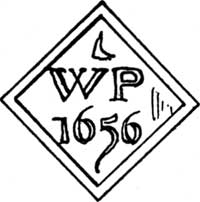< Previous
Date panel in Sussex Street, Nottingham.
By Mr. John C. Warren.

IN the interesting and valuable paper, entitled "Notes on the Domestic Architecture of old Nottingham," which Mr. H. Gill contributed to the Society's Transactions for the year 1907, reference is made to the date panel on an old brick house in Sussex Street (the Turncalf Alley of earlier days), and a representation of this panel, which is now reproduced, was given. Mr. Gill suggested with great apparent probability, that this plate, on which are the letters "W.P." and the date "1656," might indicate the house of William Petty, Bridge-master in that year. This surmise, however, would seem to be incorrect, for the writer of this note has had the opportunity recently of examining the deeds relating to the property in question—dating back some two hundred and sixty years—and they show that the premises then belonged to one William Lealand. The mark on the top of the panel, which may be readily mistaken for an ornamental device, represents the letter "L," and the initials are those of William and Phoebe Lealand. William Lealand was a dyer in Nottingham, and on the 28th of May, 1632 married Phoebe Smith, at St. Peter's Church, in that town.
By an Indenture of Feoffment, dated the 25th of October "in the year of our Lord, according to the account now used in England," 1655, Anthony Malyn, described as an "Inholder," conveyed to this William Lealand a close of some five acres, "formerly parcel of the Grayfriars," situate between" a way or lane leading to a passage or footbridge called Leen Bridge or Dyehouse Bridge, on the East," a "parcel of ground enclosed called the Fryars Close on the West," and the River Leen on the South, and also a house, "commonly called the Dyehouse situate near unto the River Leen in the aforesaid close in the tenure of William Lealand."
It is scarcely possible now-a-days to picture Nottingham at the time when all the district south of Castle Gate and the Broad and Narrow Marsh, right away to the Trent, was green meadow-land.
On part of this close, fronting the lane leading to the footbridge, William Lealand built his house in the following year, and commemorated the event by the date panel in question.
It may be of interest to refer briefly to the subsequent dealings with the property.
By his Will, dated the 2nd September, 1669, William Lealand, who is therein described as of "the Towne and Countey of the Towne of Nottingham, dier," after a more than usually lengthy exordium, embracing, among other things, the statement that it is "God's Holy will and comandment for every man to sett his house in order in this earthly tabernacle before he depart this naturall life," makes various gifts, and then proceeds, "Item, I give and bequeath unto William Lealand my third sonne All that capital messuage or tenement with the appurtenances where I now inhabite and dwell and the diehouse and the little close thereunto belonging."
The name of the testator's wife, Phoebe, does not appear in the Will, so she was then presumably dead, but a daughter "Phebie," and two granddaughters of the same name, are mentioned, and support the correctness of the interpretation given above of the initial "P" on the date panel.
William Lealand, the son, sold the property to his eldest brother, John Lealand, from whom it passed to another brother, Samuel Lealand, and then to the latter's son. This son sold it in 1717 to Edmund Wildbore, a member of the well-known Nottingham family of dyers of that name. In the conveyance the house is again dealt with under the old description, and the lane is referred to as before, but the close, which was then only about two acres in extent, is called "Tenter Close or Dyehouse Croft." Turncalf Alley, as the name of the lane, is not used in any deed prior to 1784.
In the Will of William Lealand are references to Broad Marsh, Narrow Marsh, and "St. Nichas Church Stile," and in a somewhat later document Wheeler Gate appears as " Wheelwright Gate."
The changes of the time are well illustrated by a covenant against incumbrances in the Indenture of 1655, where the property is declared to be free from all "amorciaments seizures debts and duties to the late King Charles, and to the late Keepers of the Liberty of England, or the now Lord Protector of the Common Wealth of England, Scotland, Ireland and the Dominions thereunto belonging."
< Previous
